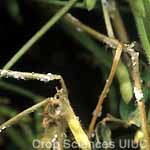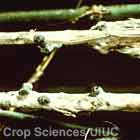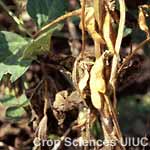Sclerotinia Stem Rot (White Mold)



Symptoms:
- Initial lesions usually develop at stem nodes during or after flowering.
- The lesions expand and the tops of the plants initially become grayish-green and then wilt and die.
- Infected areas often become soft and watery, and become covered with white moldy growth in moist conditions.
- Hard, black sclerotia develop on or inside infected stems and pods.
- Occurrence of white mold varies widely from year to year and from location to location.
Pathogen Involved:
- Sclerotinia sclerotiorum (a fungus).
- Survives from year-to-year in soil or stems in the form of hard black masses of mycelium (sclerotia).
- Sclerotia germinate near the soil surface to form small mushroom-shaped structures called apothecia, which produce ascospores that are spread by wind to infect dead soybean flowers.
- Seed lots can be contaminated with sclerotia and seeds can be infected with the pathogen.
- The host range of this pathogen includes many broadleaf plants, but not corn or small grains.
Time of Occurrence:
- After flowering.
Conditions Favoring Disease:
- Cool moist weather is required for this diseases to occur.
- Narrow rows.
- High fertility.
- Lack of air circulation under soybean canopy.
- Early planting.
- High plant populations.
Disease Management:
For more information on white mold, go to http://whitemold.uiuc.edu.
- Use seed free of Sclerotinia contamination and infection.
- Reduce or avoid irrigation until seed has set.
- Careful selection of soybean varieties may be helpful because some varieties are more susceptible than others.
- Foliar fungicides may be beneficial but may not be economically beneficial.